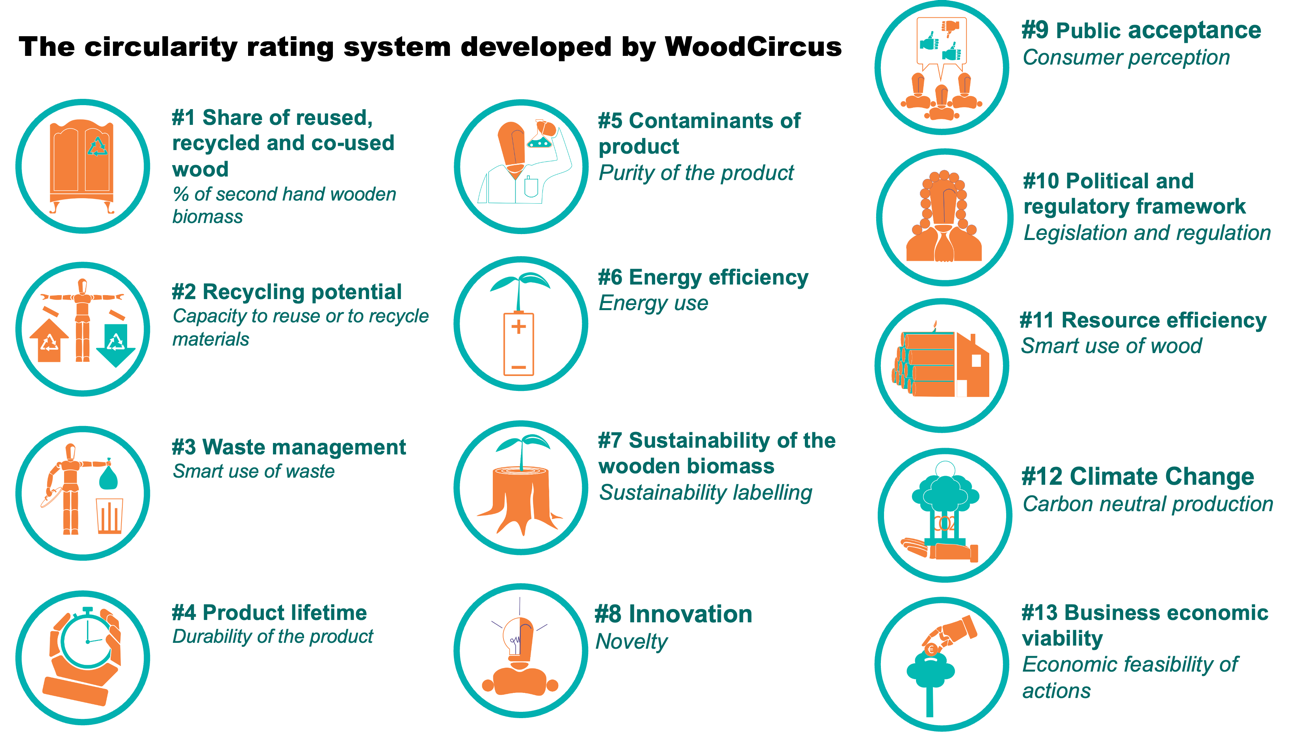Woodcircus
Main outcomes
European woodworking industries’ best practices in the circular economy
Looking into the role of the forest-based sector in the Circular Bioeconomy, we had to outline the stage of circularity. Now that wood is subject to fluctuations of prices, it feels even more urgent to update anyone about the approaches to make products and businesses circular. We need to think more about how wood can become a circular resource!
We summarized our findings from two of our work packages on a circular rating system for wood products and a good practices catalogue in 5 things that anyone should know.
- Measuring circularity of wood requires a rating system of 13 indicators
Monitoring the production, design and business changes towards circularity is a very hot-discussed topic these days. Problems start with diverging Circular Economy (CE) definitions and end with the challenge how to compare different product groups, materials, and benchmark products. WoodCircus opened the discussion with industry experts on how circularity of wood shall be measured. The outcome is a rating system with the following 13 social, economic, and environmental indicators:

2. Circularity of wood requires reuse & recycling, maximum processing efficiency, waste and side stream utilisation and new circular operational concepts
How can wood become circular? From a CE perspective, this is a simple matter of product, process, and system design to eliminate wood waste. Eco-design can surely have great impact on reuse and recycling possibilities. However, in the production of sawn wood it is virtually impossible to not lose valuable particles. On the one hand these residues for example can be further utilised in different applications. On the other hand, a company can optimize the production to be more efficient and not lose waste. Finally, there are more and more circular business models that boost circularity because they are fully aligned to cycling and maximum efficient use of materials.
3. There are different regional pathways to circularity of wood in Europe
In central Europe, circular operations are seen in recycling and effective valorisation of side streams in high value products. One prominent example is bio- composite production from waste residues that can be used in multiple applications. Meanwhile, northern European companies often work together and have innovative business models that work to let waste phase out. Eastern European countries stand out with the large diversity of forest resources and in the development of new business model opportunities such as the collection and reuse of old doors and window frames. And in the South, the most supportive public perception needed for the development of circular economy practices is situated.
4. Circular practices can be transferred around Europe to achieve circularity of wood
Transferring circularity booster practices around Europe would be the large deal for bringing circularity of wood to a whole new level. One example for which this would make sense is the national consortium for recycling of wooden packaging wastes like boxes, crates, cable drums and pallets. The recovery network presents a paramount for wood recycling on national level as companies are instructed to recycle. Especially where there is great industry where a lot of wood packaging is needed, this can be very effective. Apart from that, other methods to retrieve goods at the end of their life cycle (e.g., by buyback or apps for collection) seem to be transferable practices that have great potential for the circular economy.
5. Cooperation systems especially foster the circularity of the wood sector
One thing that is special about the European wood sector is the strong cooperation of industry actors. Many European initiatives like Wood4Bauhaus drive the companies to change and co-creation. On the one hand reducing pressures on the European forests, which can be achieved by circular operations, seems like a common goal. On the other, there is still much to do to make the efficient use of wood possible. Especially, the regulations must keep up with the pace of the companies innovating and working together.
Looking into the stage of circularity of the wood sector requires to spot the circular light on practices of reuse and recycling, waste and side stream utilisation, efficiencies, and circular operational concepts. Within Europe the pre-conditions vary a lot. While in the South, circular wood products are supported by the broad society, the East has the advantage of a large diversity of forest resources and in Northern and Central Europe most circular activities are oriented towards reuse and recycling and the effective use of wood. Some practices could boost circularity immensely if being transferred around Europe such as a national consortium for recycling of packaging wood or new innovative approaches of buy-back schemes and apps used for collection. A great driver for the circularity of wood resources is that within the wood-processing industries one can find great cooperation. Nevertheless, the wood-processing industry will only get the circular ball rolling when the process evaluation and measurement of circular practices by an indicator system as proposed in this project is successfully implemented and utilised.
CONTACT US
Interested in joining the WoodCircus network? Please use the contact form to get in touch with us or contact directly the WoodCircus Ringmaster :
Project Coordinator
Anne-Christine Ritschkoff, VTT
Anne-Christine.Ritschkoff@vtt.fi
PROJECT COORDINATOR
VTT Technical Research Centre of Finland Ltd
Anne-Christine Ritschkoff
Anne-Christine.Ritschkoff@vtt.fi


